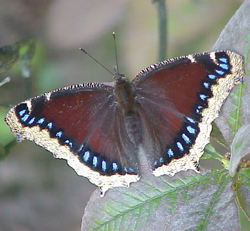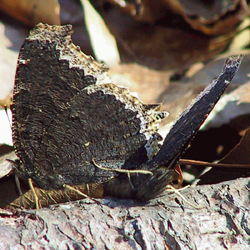Butterfly Atlas
Find a Butterfly
Mourning Cloak
Nymphalis antiopa
Named
Linnaeus, 1758

Identification
Wingspan: 2 7/8 - 3 3/8". The appearance of this butterfly with its dark wings and pale ragged margins is unique. Above, the pale yellow border contrasts sharply with the deep maroon wing surfaces. Below the wing scales are largely ash colored with the wing borders dusky yellow in fresh individuals.
Distribution
Holarctic, occurring throughout much of the temperate and subarctic portions of Europe, Asia, and North America and extending as far south as South America. In North America this butterfly is found from the edge of the arctic tundra across Alaska and Canada and south through the central Mexican highlands in the West and in the East to Florida, although its occurrence is rare south of the Appalachian Mountains. Throughout New England.
Status in Massachusetts
Common statewide. T. W. Harris‘ (1862) early account mentions finding the larvae "in such profusion on the willow and elm, that the limbs bent under their weight . . ." Scudder (1889) also considered the Mourning Cloak to be abundant and remarked that their larvae were at times "so numerous as to become positively injurious . . ." Maxima: 17, 23 April 1992, Moose Hill WLS, Sharon (Norfolk Co.).

Flight Period in Massachusetts
Tradition holds that this species may be seen during any of the winter months after several consecutive days of warm temperature. It is certainly among the earlier species to be seen in the spring, even flying before the snow has fully melted. Normal flight period from April through October with peaks in the first week of May and the second week of July. These peaks probably correspond with the mating of the overwintered adults in May and the emergence of their brood in July. The species has been seen in flight in Massachusetts during every month. [11 January 1995 Chatham (Barnstable Co.) fide R. Prescott]
Larval Food Plants
Primarily tree species, especially willows (Salix spp.), poplars (Populus spp.), birches (Betula spp.), American Elm (Ulmus americana), and hackberry (Celtis spp.). Plants less frequently used include alders, hornbeam, maples, Red Mulberry, American Basswood, White Ash, Mountain Ash, spireas, and roses.
Adult Food sources
Nectars on flowers only sparingly, but occasionally visits Common Milkweed, lilacs, dogbane, and Pussy Willow. Feeds most often on tree sap, particularly from oaks. Frequently visits the sap wells kept open by sapsuckers. Also feeds on fermenting fruit and visits mud puddles.

Habitat
Primarily a species of hardwood forests and woodlands, but this butterfly ranges widely and may be seen in most habitats.
Life Cycle
EGG: White to tan; turban shaped, with seven or eight vertical ribs. OVIPOSITION: Groups of approximately 250 eggs laid in rings around twigs of host plant. LARVA: Largely velvet black with white speckles and a single row of orange markings on back; covered with long branching spines; prolegs are red. CHRYSALIS: Dark yellowish brown, somewhat resembling a dried, shriveled leaf. OVERWINTERING STAGE: Adult
Mourning Cloaks emerge from hibernation in April and mate through May. Eggs hatch in 10 to 12 days and the young larvae are gregarious and feed in a communal web. The mature larvae wander before pupating, and emerge from the chrysalis in about 11 days, usually in early July. Although this species may be seen throughout the summer, most enter aestivation shortly after emergence from the chrysalis (Young 1980), lying dormant in a hollow tree or similar place until fall when a portion of the population migrates southward (Teale 1955). The remaining adults spend the fall feeding before they re enter hollow trees and woodpiles to hibernate through the winter. The adult‘s lifespan of over ten months is extremely long for a temperate butterfly.
Account Author
Dr. Thomas French



